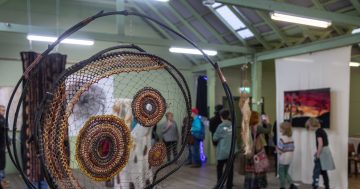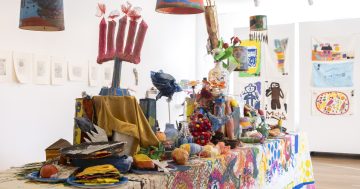
Euan Macleod, Triptych – figure in a dissolving landscape, 2020, oil on polyester, 200 x 440cm. Photo: artist and King St Gallery, Sydney.
Euan Macleod is a New Zealand-born artist who moved to Sydney in 1981 at the age of 25, where he has established a reputation as one of Australia’s most prominent and popular figurative artists.
Macleod’s exhibition Flux comes to the ANU Drill Hall Gallery after its debut at the Orange Regional Gallery.
Flux is a powerful and impressive exhibition of Macleod’s paintings made on the Haupapa Tasman Glacier on New Zealand’s South Island. Some of the paintings were executed in situ, ‘en plein air’, with the artist struggling with the elements. Others are huge works that he executed back in his Sydney studio.
It is a moving and deeply personal exhibition celebrating the sublime majesty of the Southern Alps, but it also expresses vulnerability and fragility. Macleod, as an artist, needs to be challenged and placed outside his comfort zone, and this inspires him to make art to bring stability to his world.

Euan Macleod, Over the edge, 2023-24, oil on polyester, 210 x 400cm. Photo: artist and King St Gallery, Sydney.
These mountains that he visited as a child filled him with terror. Now, many decades later, he still experiences the sense of vertigo while looking into the void, but he also now senses how the mountains themselves have become vulnerable and are facing destruction.
In this encounter with the Haupapa Glacier, Macleod was experiencing climate change close-up. Whole areas that he knew as a child had gone; vast chunks of ice were collapsing before him, and the whole glacier looked as if under threat. The glacier that for most of the 20th century, remained a constant 28 kilometres in length, started to rapidly shrink in the 1990s and will probably disappear completely within a couple of decades.

Euan Macleod, Self portrait and mountain triptych, 2023-24, oil on polyester, 180 x 522cm. Photo: artist and King St Gallery, Sydney.
In one of the huge paintings in this exhibition, Macleod’s Self portrait and mountain triptych, 2023-24, that measures almost five-and-a-half metres across, the human figure appears as an intrusion surrounded by vast walls of ice that can collapse at any second. The palette is sombre as the artist observes the alpine setting both at day and at night.
Macleod embraces the European tradition of the romantic sublime, drawing on the heritage of artists including JMW Turner, Caspar David Friedrich and Eugene von Guerard. The idea is that you embrace a terrifying beauty that dwarfs human existence and you stand in awe before the power of nature.

Euan Macleod, Roped figures above clouded valley, 2023, acrylic on polyester, 210 x 400cm. Photo: artist and King St Gallery, Sydney.
Almost in contrast with this, Macleod introduces huge lurking figures in a number of his paintings, including Over the edge, Triptych – figure in a dissolving landscape and Roped figures above clouded valley, as if emerging out of the ice and snow. They remind me of the lurking giant in Goya’s The Colossus. In this way, the paintings bring together awe-inspiring images of mountain scenery covered with ice and snow and the menacing human presence. In a strange way, the alpine landscape is morphed into a self-portrait of the artist, perhaps not in a literal sense, but at least capturing the emotional state of the artist.
Macleod loves playing with fields of colour and works at speed, losing control of the painting until it achieves its own voice, which comes as a surprise to the artist. A work like Roped figures above clouded valley captures the transition between a closely observed figure descending on a rope and an encounter with a vast mystical expanse containing a huge phantom-like figure disappearing into the landscape.

Euan Macleod, Fool on a hill, 2023, acrylic on polyester, 210 x 400cm. Photo: artist and King St Gallery, Sydney.
The curator of the exhibition, Bradley Hammond, the director of Orange Regional Gallery, travelled with the artist by helicopter to the Haupapa Tasman Glacier and stayed with him for about a week, observing him work out in the elements. The artist experienced both fear and ecstasy, and these have flowed into his art.
There is a freshness, immediacy and power in this exhibition – a vibrancy that is rarely encountered in contemporary Australian landscape painting. This show is a partnership exhibition between the Orange Regional Gallery and the ANU Drill Hall Gallery.

Euan Macleod painting on Haupapa Tasman Glacier. Photo: Bradley Hammond, Orange Regional Gallery.
Euan Macleod, Flux, is at the ANU Drill Hall Gallery, Kingsley St, Acton until 3 November. It’s open Wednesday to Sunday, from 10 am to 5 pm.

















